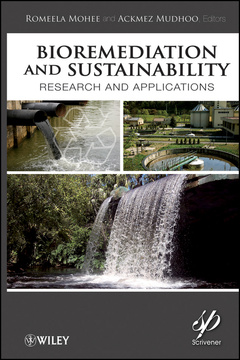Description
Bioremediation and Sustainability
Research and Applications
Authors: Mohee Romeela, Mudhoo Ackmez
Language: English
Keywords
uptodate; important; treatment; bioremediation; lowcost; research; applications; promotion; sustainable; environmental engineering; chemical; constant; transform; toxic forms; less; order; uses; organisms; living; technique; enzymatic
438 p. · 16.3x24.2 cm · Hardback
Description
/li>Contents
/li>Biography
/li>
Bioremediation and Sustainability is an up-to-date and comprehensive treatment of research and applications for some of the most important low-cost, "green," emerging technologies in chemical and environmental engineering
Sustainable development requires the development and promotion of environmental management and a constant search for green technologies to treat a wide range of aquatic and terrestrial habitats contaminated by increasing anthropogenic activities with the main sources of contaminants being the chemical industries. Bioremediation is a technique that uses living organisms in order to degrade or transform contaminants into their less toxic forms. It is based on the existence of microorganisms with the capacity to attack the compounds on the enzymatic level.
Bioremediation is an increasingly popular low-cost alternative to conventional methods for treating wastes and contaminated media with the possibility to degrade these contaminants using natural microbial activity mediated by different consortia of microbes. Over the last few years, the scientific literature has revealed the progressive emergence of various bioremediation techniques. Bioremediation and Sustainability presents an up-to-date and comprehensive collection of chapters prepared in bioremediation technology research and applications.
The strategies covered in this volume can be applied in situ or ex situ, depending on the site in which they will be applied. In situ is the treatment done in the site of the contamination, and ex situ involves the removal of soil or water to subsequent treatment. There is a wide variety of techniques that have been developed in the past and are covered in this volume, such as natural attenuation, bioaugmentation, biostimulation, biosorption, composting, phytoremediation, rhizoremediation, and bioleaching.
Preface
Acknowledgements
Editor
List of Contributors
Chapter 1. Elements of Sustainability and Bioremediation
Ackmez Mudhoo and Romeela Mohee
Chapter 2. Natural Attenuation
R. Ryan Dupont
Chapter 3. Anaerobic Digestion Processes
Steven I. Safferman, Dana M. Kirk Louis L. Faivor, Wei Wu-Haan
Chapter 4. Biosurfactants: Synthesis, Properties and Applications in Environmental Bioremediation
Ramkrishna Sen, Ackmez Mudhoo and Gunaseelan, D.
Chapter 5. Phytoremediation: An Efficient Approach for Bioremediation of Organic and Metallic Ions Pollutants
Divya Gupta, Lalit Kumar Singh, Ashish Deep Gupta and Vikash Babu
Chapter 6. Bioleaching
Leo G. Leduc and Garry D. Ferroni
Chapter 7. Biosorption of Heavy Metals – New Perspectives
Teresa Taveres and Hugo Figueiredo
Chapter 8. Biofiltration: Essentials, Research and Applications
Smita Raghuvanshi, Subhajit Majumder and Suresh Gupta
Chapter 9. Modeling and Implementation of Sustainable Remediation Based on Bioventing
Hillel Rubin, Eran Rubin, and Holger Schüttrumpf
Chapter 10. Bioremediation of Xenobiotics
Kamal Saxena, Gajendra Kumar Aseri, Ashish Deep Gupta and Vikash Babu
Index
Romeela Mohee, PhD, is Professor of Environmental Engineering in the Department of Chemical and Environmental Engineering at the University of Mauritius. She obtained her PhD at the University of Mauritius in 1998, and her primary research interests are in waste containment, solid waste management and treatment by anaerobic digestion and composting, beneficial reuse of waste materials, and heat and mass transfer modeling. An eminent international consultant in environmental science and energy issues, Dr. Mohee has authored or contributed to over 70 international publications on waste biotreatment, including four books and numerous conference papers and consultancy reports.
Ackmez Mudhoo, MPhil, is Lecturer in the Department of Chemical and Environmental Engineering at the University of Mauritius. His main research interests encompass the design of composting systems, analysis of composting processes, and the biological treatment of solid wastes and wastewater. He has dozens of international journal publications and conference papers to his credit. He is also a peer reviewer on numerous journals, and is the editor-in-chief for two international research journals.




